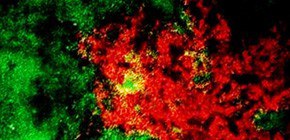
Critical role of tissue-resident M2-like macrophages clarified
Far-reaching impact of Trib1: tissue maintenance & suppression of metabolic disorders
Under the leadership of SATOU Takashi , Assistant professor and AKIRA Shizuo , Professor and Director, Immunology Frontier Research Center ( IFReC ), Osaka University, a group of researchers discovered a macrophage similar to M2 macrophages* residing in peripheral tissues (hereafter referred to as "tissue-resident M2-like macrophages"). Furthermore, they discovered a gene responsible for the differentiation of such cells, Tribble1 (Trib1).
This group demonstrated for the first time in the world that Trib1-deficient mice developed lipodystrophy as well as metabolic disorders caused by lipodystrophy.
*(M2 macrophages are special cell populations that are thought to be involved in human diseases such as cancer, allergies, metabolic syndrome, and tissue regeneration. This group had been conducting research using allergen-induced M2 macrophages. Prior to this research the generation mechanism and function of tissue-resident M2 macrophages ["MS-like"] had been unknown.)

This group examined expression patterns of genes related to the differentiation and activation of macrophages and paid attention to the gene Trib1. In Trib1-deficient mice, tissue-resident M2-like macrophages in peripheral tissues significantly diminished and, furthermore, as noted above, these mice developed lipodystrophy. Fed calorie-rich food, these knockout mice manifested worsened metabolic syndrome than in the case of wildtype mice.
Macrophages were thought to have aggressive characteristics of attacking phasogens; however, this group's research clarified that tissue-resident M2-like macrophages maintained peripheral tissues such as fat cells.
This group's achievement will play an important role in the future development of drugs for reducing lipodystrophy and metabolic syndrome conditions. Examining various types of macrophages will lead to the possible development of therapeutic agents, including ones for diseases such as cancer and arteriosclerosis.
Abstract
Macrophages consist of at least two subgroups, M1 and M2. Whereas M1 macrophages are proinflammatory and have a central role in host defence against bacterial and viral infections, M2 macrophages are associated with responses to anti-inflammatory reactions, helminth infection, tissue remodelling, fibrosis and tumour progression. Trib1 is an adaptor protein involved in protein degradation by interacting with COP1 ubiquitin ligase. Genome-wide association studies in humans have implicated Trib1 in lipid metabolism. Here we show that Trib1 is critical for the differentiation of F4/80+MR+ tissue-resident macrophages—that share characteristics with M2 macrophages (which we term M2-like macrophages)—and eosinophils but not for the differentiation of M1 myeloid cells. Trib1 deficiency results in a severe reduction of M2-like macrophages in various organs, including bone marrow, spleen, lung and adipose tissues. Aberrant expression of C/EBPα in Trib1-deficient bone marrow cells is responsible for the defects in macrophage differentiation. Unexpectedly, mice lacking Trib1 in haematopoietic cells show diminished adipose tissue mass accompanied by evidence of increased lipolysis, even when fed a normal diet. Supplementation of M2-like macrophages rescues the pathophysiology, indicating that a lack of these macrophages is the cause of lipolysis. In response to a high-fat diet, mice lacking Trib1 in haematopoietic cells develop hypertriglyceridaemia and insulin resistance, together with increased proinflammatory cytokine gene induction. Collectively, these results demonstrate that Trib1 is critical for adipose tissue maintenance and suppression of metabolic disorders by controlling the differentiation of tissue-resident M2-like macrophages.

Figure 1

Figure 2

Figure 3

Figure 4

Figure 5
To learn more about this research, please read the full research report entitled " Critical role of Trib1 in differentiation of tissue-resident M2-like macrophages " at this page of the Nature website.
Related link :

